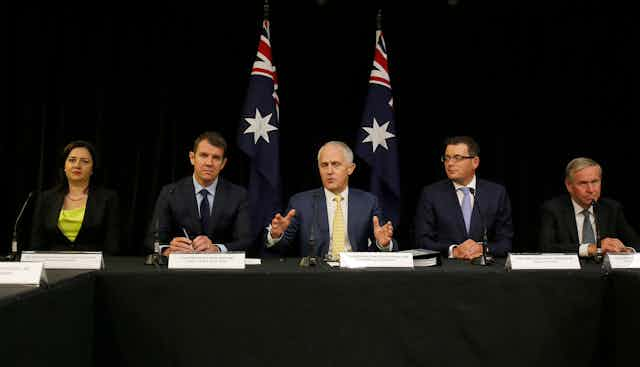Prime Minister Malcolm Turnbull’s proposal to hand over to the states some of the income tax powers now held exclusively by the Commonwealth is perhaps the most extraordinary event in recent Australian political history.
If it happens it will overturn nearly a century of the Commonwealth accumulating power at the expense of the states, commencing with the Engineers Case in 1920. The Uniform Taxation Act in 1942 helped to accelerate the process by giving the Commonwealth exclusive control over income tax.
The long-term consequences have been that while the states continue to deliver crucial services to the public, especially in health and education, they lack the financial capacity to fund those services without Commonwealth assistance. Hence, beginning in the 1950s, the Commonwealth began funding education, firstly universities and later schools, as the states proved incapable of providing sufficient funds for them.
This condition where the central government raises more money than it needs and the states are incapable of doing so is referred to as vertical fiscal imbalance. It means, in practice, that the Commonwealth is able to use its excess funds to dictate policy to the states. The states become subordinate entities to the Commonwealth.
It is interesting to note that Turnbull refers to the states as sovereign entities. They are in their areas of responsibility, but the power conferred on the Commonwealth through vertical fiscal imbalance has seriously eroded that sovereignty. The states have become mendicants who regularly go to Canberra to beg for money.
Equally of note is the use of the word “subsidiarity” in the Commonwealth government’s first federation issues paper from 2014:
“subsidiarity, whereby responsibility lies with the lowest level of government possible, allowing flexible approaches to improving outcomes.”
If subsidiarity is to be a fundamental principle of governing in Australia, then those responsible must also be financially responsible. Otherwise they cannot be sovereign and just become tools of the central government.
In the final analysis it all comes down to finance and financial independence.
The problem is that at present the Commonwealth holds the whip hand in financial matters. To achieve subsidiarity and make states genuinely responsible they will need to find sources of funding outside of going to the Commonwealth.
Unfortunately, the cards are stacked against them as the High Court has ruled that “excise”, which Section 90 of the Constitution says is granted exclusively to the Commonwealth, also covers sales taxes. This is why the Commonwealth became the exclusive owner of the GST, which it distributes to the states.
As the states lost the capacity to levy income tax in 1942, their taxation options are very limited. There is land tax (including council rates), stamp duty and payroll taxes, none of which raises an enormous amount of money. They also run lotteries. This is why income taxes are viewed as the best way of restoring some of the financial independence of the states.
If the states are to levy income taxes, it only makes sense if, in the longer term, each state can determine the rate of that income tax. The great fear is that this will contravene the principle of horizontal fiscal equalisation, or the idea that each state should have the same level of service as the others. Competition, it is argued, will lead to a “race to the bottom”, with the consequence that lower taxation will lead to a lower quality of service in health and education.
But to truly restore sovereignty and the principle of subsidiarity, some power to tax income must revert to the states.
Alternative options
Turnbull has sought to encourage innovation and “agility”, and perhaps there may be other ways out of this dilemma. Here are some possibilities.
*Give states power over sales tax *·
As the High Court defines sales tax as excise, the wording of Section 90 could be changed so that sales tax is explicitly excluded from the definition of excise. This would require a referendum, but it would give the states much greater flexibility in their taxing regime. It wold mean that states could, in effect, raise their own equivalents of the GST, as happens in some other countries, thereby allowing the Commonwealth to lower the rate of its GST.
*Expand land tax *
Whenever this topic is raised one response that is invariably raised is that the states should look at ways of expanding their land tax. This could be done by increasing the rate at which land is taxed and/or lowering the threshold at which payment begins.
*Restore inheritance taxes *
The states once raised funds through inheritance taxes, but these were abolished some 40 years ago. Given the amount of money now locked up in real estate in places like Sydney and Melbourne, there could be significant sums to be raised in this way.
Moreover capital acquired by simply living in a house for a certain number of years can hardly be compared to the money one earns working at an occupation. Beneficiaries of an estate cannot be construed as having deserved their inheritance.
In all of the cases listed above the imposition of any such state taxes would need to be matched by a decrease in Commonwealth taxes.
The restoration to the states of some power to impose income tax appears on the surface to be the best way of both restoring sovereignty and embedding subsidiarity into the practice of government in Australia. There is much to be said for doing it. But if we are to grasp the opportunities of the present we need to consider other possible options.
What matters is less the means than the end: to restore Australia to a genuine federation.

